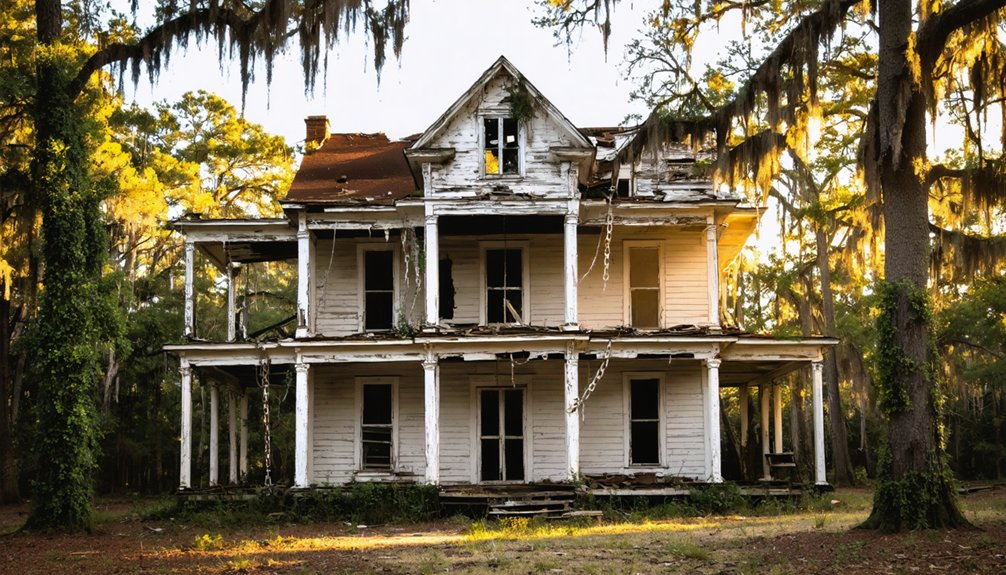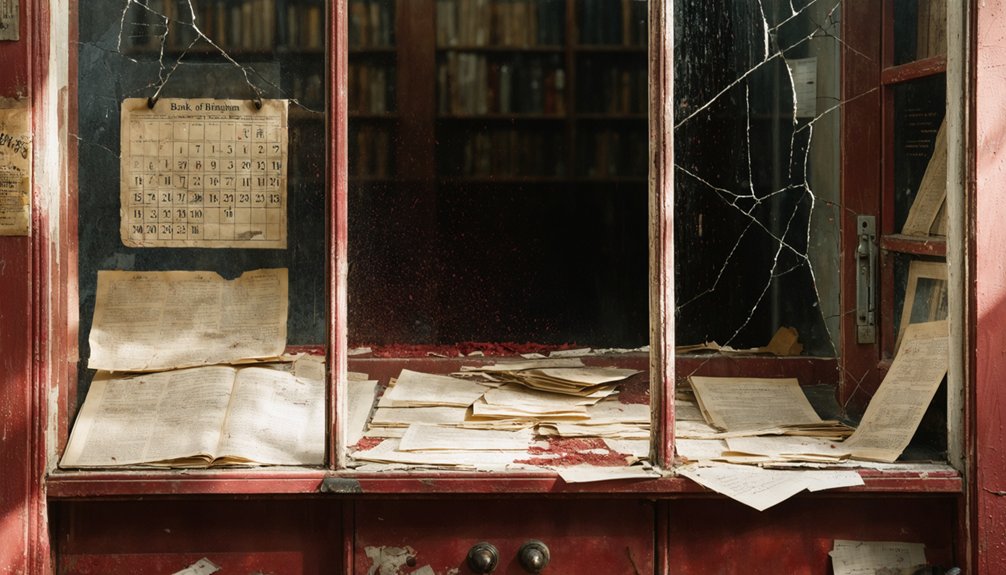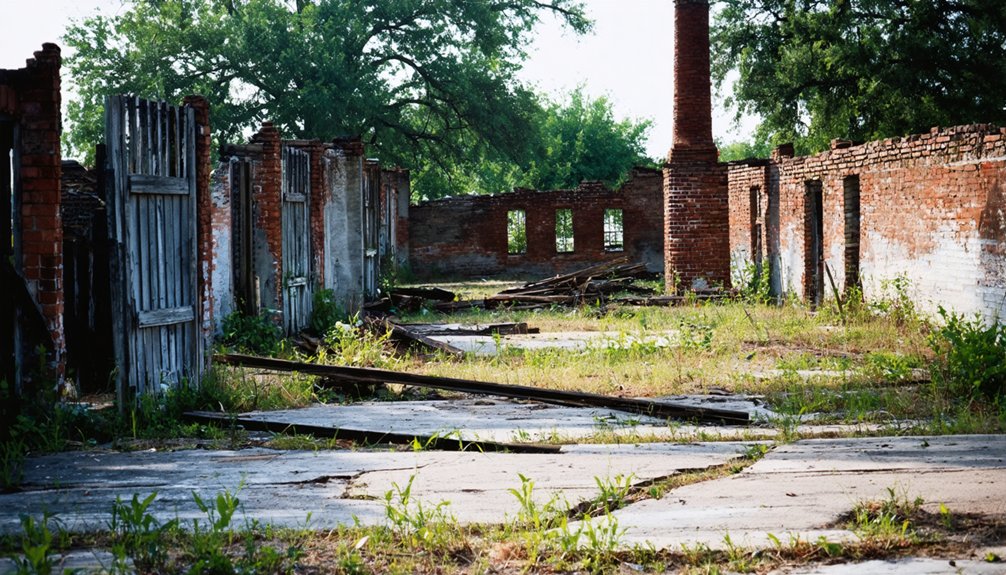You’ll find New Birmingham’s ghostly remains along U.S. Highway 69 in East Texas, where three massive iron furnaces once dominated the skyline in the 1890s. The town boasted 1,500 residents, electric lights, and the grand Southern Hotel during its brief industrial heyday. After a tragic murder, an alleged curse, and the Panic of 1893, this iron boomtown crumbled. Today, only a historical marker and hidden furnace fragments reveal its ambitious past.
Key Takeaways
- New Birmingham, founded in 1880s Texas, was an ambitious iron-producing town that grew to 2,000 residents before becoming a ghost town.
- The town featured three massive furnaces, modern amenities, and the luxurious Southern Hotel during its brief industrial peak.
- General Hammon’s murder in 1891 and his widow’s alleged curse coincided with the town’s rapid decline.
- The Panic of 1893 devastated New Birmingham’s economy, forcing iron furnaces to close and residents to abandon the town.
- Today, only a historical marker and hidden furnace ruins remain, with the last significant structure burning down in 1926.
The Birth of an Iron Empire
While many Texas ghost towns faded quietly into history, New Birmingham burst onto the industrial scene in the late 1880s with grand ambitions to become the “Iron Queen of the Southwest.” Founded by Alexander B. Blevins, a savvy sewing machine salesman from Alabama, this bold industrial venture aimed to tap into East Texas’s rich iron oxide deposits.
You’ll find the community foundation was built on more than just dreams – Eastern investors and General W. H. Hammon poured substantial capital into the project. Two massive furnaces, the Star and Crescent furnace, along with the Tassie Bell, demonstrated the town’s production capabilities by generating 100 tons of pig iron each day. The town’s rapid growth attracted nearly 2,000 residents by 1891, showcasing its potential as a major industrial center.
Industrial Glory Days
Three massive smokestacks dominated New Birmingham’s skyline during its industrial peak in the early 1890s, marking an era of remarkable manufacturing diversity.
You’d have witnessed industrial innovation firsthand at the Tassie Belle blast furnace, churning out fifty tons of iron while the New Birmingham Pipe Works produced 25 tons of cast-iron pipe daily.
Much like its Irish namesake which had grand canal plans for coal transport, the town’s rapid community growth brought modern conveniences you wouldn’t expect in 1890s Texas – electric lights powered by coal, an ice plant, and steam laundry.
With a monthly payroll reaching $18,000, the town bustled with 1,500 residents across 400 buildings.
The impressive Southern Hotel, costing $60,000, welcomed visitors from across America, while fifteen brick business blocks housed everything from banks to saloons.
The town’s founder Anderson B. Blevins envisioned creating an industrial powerhouse to rival his home state’s Birmingham, Alabama.
The Murder That Shook the Town
In 1891, you’ll find the defining tragedy of New Birmingham when General Hammon was shot dead on a town lawn during a power plant dispute, with the young shooter receiving a manslaughter conviction.
You can trace how this incident sparked widespread panic when the red-haired bride ran through the business district screaming about Mrs. Hammon’s curse on the town.
The murder’s aftermath left an indelible mark on New Birmingham’s history, as locals attributed subsequent industrial failures and the town’s eventual abandonment to Mrs. Hammon’s legendary curse.
The Kansas and Gulf Short Line Railroad ran along the eastern edge of town, once carrying hopeful investors and ambitious developers to the promising settlement.
A devastating fire in 1893 destroyed the mining facility, leading to a mass exodus of residents and businesses from the once-prosperous town.
Fatal Power Plant Dispute
During the early 1890s, New Birmingham experienced its most shocking incident when Confederate General William H. Hammon was fatally shot at the Southern Hotel.
The power struggle began when a young Tennessee man clashed with Hammon’s wife, leading to a violent confrontation. You’ll find it notable that the perpetrator fired his pistol twice, killing the General instantly.
The societal impact of this incident reverberated throughout the community. Mayor Joe D. Eaker swiftly responded, and the shooter faced justice in a trial that captivated local media. Similar to the case of Geoffrey West in Alabama, the perpetrator received a lesser manslaughter conviction and a two-year sentence instead of capital punishment.
Though charged with homicide, he received a lesser manslaughter conviction and a two-year sentence. This tragedy, combined with Mrs. Hammon’s alleged curse on the town, became intertwined with New Birmingham’s subsequent industrial failures and ultimate abandonment.
Cooney’s Swift Pardon Aftermath
Life in New Birmingham took a dark turn when Christopher Jay Swift brutally murdered his wife and mother-in-law in 2003. The violent strangulation and assault of two women sent shockwaves through Denton County, intensifying the ghost town’s haunting reputation.
Swift’s potential pardon implications stirred heated debates about justice and rehabilitation, dividing local opinions. Similar to Daniel Perry’s case where stand your ground laws influenced the governor’s position on pardoning, the community struggled with complex questions of justice. You’ll find that community trust in the judicial system was severely tested as discussions arose about his previous four-year sentence for aggravated assault. Similar to the Birmingham case where an all-women jury determined the fate of a husband who killed his wife, the community grappled with questions of appropriate sentencing for crimes of passion.
The case transformed New Birmingham’s narrative, leading to increased fear among residents and accelerating the area’s economic decline.
The tragedy’s lasting impact prompted civic groups to address domestic violence awareness and healing. Today, the Swift case serves as a somber reminder in law enforcement training about the devastating consequences of escalating abuse.
Widow’s Legendary Town Curse
A century before Christopher Swift’s crimes darkened New Birmingham’s legacy, another shocking murder rocked the prosperous iron town to its core.
When S.T. Cooney gunned down General W.H. Hamman at the Southern Hotel in 1890, he couldn’t have known his actions would spawn one of Texas’s most enduring legends.
The Widow’s motivations emerged from a perfect storm of personal tragedy and perceived injustice.
After Cooney received his pardon in 1892, Ella Hamman, the town’s renowned red-haired beauty, released her famous curse.
You can still picture her running through the streets, hair flowing wild, calling for divine retribution to destroy the “mushroom town.”
While curse interpretations vary, the town’s subsequent collapse – from the Tassie Belle furnace explosion to the Southern Hotel’s fiery end – left many wondering about supernatural vengeance.
The once-bustling town that boasted 32 mercantile houses quickly became a shadow of its former glory.
The Legend of Mrs. Hammon’s Curse

When General W. H. Hamman was shot dead by S. T. Cooney in 1890, no one could’ve predicted how this tragedy would spawn one of East Texas’ most enduring curse origins.
After Cooney received a mere two-year sentence and subsequent pardon, Mrs. Hammon’s grief transformed into a legendary act of town folklore that would haunt New Birmingham forever.
- Mrs. Hammon, sister to Tassie Belle Blevins, publicly called for divine retribution
- She demanded the surrounding forest reclaim the town entirely
- The curse gained potency as economic disasters struck New Birmingham
- Locals connected every misfortune to her supernatural condemnation
The curse’s power grew stronger as New Birmingham faced its inevitable decline, with the Panic of 1893 and iron market collapse sealing its fate.
Today, you’ll find only scattered ruins where this once-promising town stood, seemingly swallowed by the forest just as Mrs. Hammon wished.
Economic Devastation and the Panic of 1893
The Panic of 1893 struck New Birmingham with devastating force, turning Mrs. Hammon’s prophetic words into reality. As the national economic crisis unfolded, you’d have witnessed the town’s iron furnaces and factories shuttering amid plummeting industrial production.
The economic impact rippled through the community as banks failed and businesses collapsed, mirroring the broader devastation that saw over 15,000 companies nationwide go bankrupt.
The Panic of 1893 unleashed a cascade of failures, with thousands of businesses crumbling under the weight of economic collapse.
The societal response in New Birmingham reflected the nationwide struggle, with unemployment soaring and families losing their homes to foreclosure.
You can still see evidence of this devastation in the abandoned buildings and crumbling foundations that remain. Like many industrial boom towns of the era, New Birmingham couldn’t survive the perfect storm of bank failures, railroad bankruptcies, and the severe credit contraction that defined the Panic of 1893.
Foreign Investment Troubles and Legal Barriers

Despite New Birmingham’s promising industrial potential, foreign investment troubles and legal barriers dealt a severe blow to the town’s development aspirations. When British syndicate Baring Brothers pledged over $1,000,000 in investment, it seemed the town’s financial struggles would end. However, Texas’s Alien Land Law, championed by Governor James Hogg, crushed these hopes by prohibiting foreign ownership of land-based companies.
- The law’s timing couldn’t have been worse, blocking vital British capital just as deals were near completion.
- NBI&D’s management hosted an elaborate banquet to lobby Governor Hogg, but he wouldn’t budge.
- Without foreign investment, the town couldn’t sustain its industrial operations.
- Local funding proved insufficient to maintain momentum, accelerating New Birmingham’s decline.
This legal roadblock, reflecting period nativist sentiments, effectively sealed the town’s fate.
The Last Days of the Southern Hotel
Standing proudly as New Birmingham’s crown jewel until 1893, the Southern Hotel‘s final days reflected the town’s dramatic downfall.
You would’ve witnessed the hotel grandeur fade as its 99 rooms, once filled with the sounds of orchestras and clinking glasses, fell silent. The $60,000 landmark, with its hand-carved wainscoting and electric lighting, stood as a ghostly reminder of shattered dreams.
For over three decades, you could’ve seen this magnificent three-story brick structure weather the social decline, standing empty against the East Texas sky.
The hotel that once hosted governors and ambitious investors became a hollow shell until 1926, when flames consumed its remains.
Today, you’ll find no trace of this monument to frontier ambition – just stories of what might’ve been.
What Remains Today: A Ghost Town Legacy

Today, if you venture south of Rusk along U.S. Highway 69, you’ll find little evidence that New Birmingham once stood proudly as the “Iron Queen of the Southwest.” A solitary Texas historical marker, erected in 1966, serves as the primary evidence to this vanished town’s existence.
For those determined to explore this ghost town‘s remains, you’ll discover:
- Dense forest and poison ivy concealing fragments of the original iron furnaces
- Tassie Belle Historical Park’s remnants offering glimpses of industrial ruins
- No preserved structures, as buildings were dismantled and materials scavenged
- Limited accessibility with no maintained trails or visitor facilities
The site’s legacy lives on primarily through historical records, with the Texas Historical Commission maintaining archival files that document New Birmingham’s dramatic rise and fall in East Texas history.
Frequently Asked Questions
What Happened to the Families Who Lost Their Homes During Abandonment?
Like hitting a delete button, your world disappeared. Family displacement scattered you to nearby towns like Rusk, forcing community resilience as you searched independently for work without organized support or compensation.
Were There Any Attempts to Establish Other Industries Besides Iron Manufacturing?
You’ll find evidence of diverse attempts beyond iron production, including lumber processing, steam bakeries, brick manufacturing, and bottling works. However, textile manufacturing and agricultural development weren’t notably pursued in the area.
How Did Neighboring Towns Respond to New Birmingham’s Rapid Rise and Fall?
You’ll find neighboring towns initially viewed New Birmingham with mixed feelings – welcoming potential jobs while fearing economic competition. When it failed, they absorbed displaced workers but grew wary of similar speculative ventures.
What Natural Resources Besides Iron Ore Were Available in the Area?
Like a treasure chest of riches, you’d find abundant timber resources, limestone quarries, salt deposits, ceramic clays, and reliable water supplies from local streams and underground sources throughout the region.
Did Any Original Buildings or Structures Survive Into the Modern Era?
You won’t find any original buildings standing today – despite their architectural significance, none survived. The last historic preservation opportunity vanished when they demolished the Academy in 1932 for highway construction.
References
- https://blogs.baylor.edu/texascollection/2017/07/19/demise-of-the-cursed-new-birmingham-texas/
- https://sites.rootsweb.com/~txcherok/4/newbirm.htm
- https://kids.kiddle.co/New_Birmingham
- https://scholarworks.sfasu.edu/cgi/viewcontent.cgi?article=1116&context=ethj
- https://www.allacrosstexas.com/texas-ghost-town.php?city=New+Birmingham
- https://www.tshaonline.org/handbook/entries/new-birmingham-tx
- https://texasescapes.com/DEPARTMENTS/Guest_Columnists/East_Texas_all_things_historical/NewBirmingham1AMD901.htm
- https://www.texasalmanac.com/places/new-birmingham
- http://www.wtblock.com/NewBirmingham.htm
- https://en.wikipedia.org/wiki/New_Birmingham



